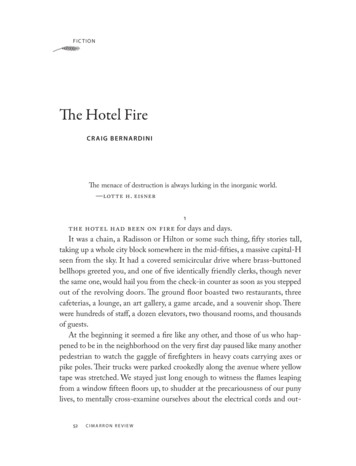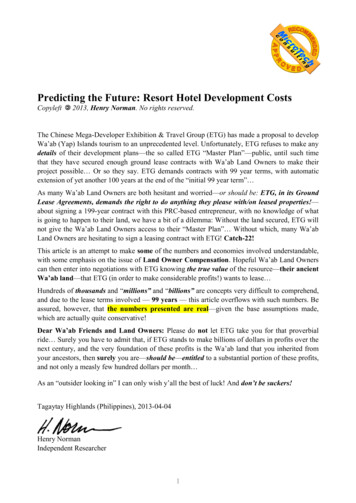
Transcription
FictionThe Hotel FireCraig BernardiniThe menace of destruction is always lurking in the inorganic world.—Lotte H. Eisner1The hotel had been on fire for days and days.It was a chain, a Radisson or Hilton or some such thing, fifty stories tall,taking up a whole city block somewhere in the mid-fifties, a massive capital-Hseen from the sky. It had a covered semicircular drive where brass-buttonedbellhops greeted you, and one of five identically friendly clerks, though neverthe same one, would hail you from the check-in counter as soon as you steppedout of the revolving doors. The ground floor boasted two restaurants, threecafeterias, a lounge, an art gallery, a game arcade, and a souvenir shop. Therewere hundreds of staff, a dozen elevators, two thousand rooms, and thousandsof guests.At the beginning it seemed a fire like any other, and those of us who happened to be in the neighborhood on the very first day paused like many anotherpedestrian to watch the gaggle of firefighters in heavy coats carrying axes orpike poles. Their trucks were parked crookedly along the avenue where yellowtape was stretched. We stayed just long enough to witness the flames leapingfrom a window fifteen floors up, to shudder at the precariousness of our punylives, to mentally cross-examine ourselves about the electrical cords and out52 c i m a r r o n r e v i e w
lets and stoves in our apartments, maybe to see the glittering cascades of glassas windows were punched out and the flames mellowed into billowing blackcloud. The rest of us watched it on the news that night, a succession of five orsix images compressed into fifteen seconds among the minute or two allottedto the day’s events. No one was hurt. No word as to the cause of the blaze.A couple of days later, when the hotel started burning again, some of ussat up and took notice. On the news, the fire trucks looked exactly the same asbefore.In the days that followed, as the crowds around the hotel multiplied and thenews and fire trucks became a near-constant presence, something of the futureof the event could already be glimpsed. Almost immediately, the media stoppedtalking about fires in the plural, and began referring to a single, spreading fire.For while it was true that individual fires were extinguished before new onesbroke out, and that they began in seemingly unrelated parts of the building, itwas difficult to ignore the persistence of the address. The hotel manager soonacquiesced—perhaps it was suggested to him that a single fire, no matter howgreat or prolonged, was finally less threatening than many—taking the opportunity to add that no guests were in danger, the situation was under control, andthat the hotel would continue to go about its business with the same courtesyand efficiency for which it was justly renowned.It was also during these formative weeks that the fire marshal stoppedblaming careless guests and staff—the maid who had purportedly tossed a litcigarette into a tub of dirty linen; the Spanish socialite who left his hot potplugged in; the errant bellboy’s unwholesome fascination with his Zippo—andbegan suggesting foul play. The tabloids soon had their man: a latter-day Bolshevik, dressed in the trench coat and black fedora of a Cold War spy, carryinga torch-sized match like the archetypal anarchist’s bowling-ball bomb. But thefoul-play thesis could not be sustained for very long, either. For by this time theguests and staff had already been interrogated and their backgrounds checked,several had been sacked for minor, unrelated offenses overlooked at the timeof their hiring, and several more were being held for deportation. In the faceof questions from reporters about potential suspects, the marshal was forced toadmit that investigators had not yet turned up a shred of evidence pointing toarson. However, the marshal reasoned, it being true that the cause of every fireleft a trace, the only plausible explanation for the absence of said trace was thec i m a r r o n r e v i e w 53
presence of a malign hand acting intentionally to erase it.With no leads among the staff or registered guests, and despite the apparentmomentary absence of fire, the city ordered an evacuation, which the policeclosely monitored, and the premises were searched from roof to cellar, room byroom, in the company of the superintendent and his Brobdingnagian ring ofkeys. They found no one. What’s more, it was only after the fire marshal hadgiven the all-clear sign, but before anyone had been readmitted to the hotel,that the fire broke out anew.We couldn’t blame them, not the police and firefighters, not the media, manager, or mayor, not the city as a whole, for wanting the fire to have some agent,some cause, something or someone you could point a finger at, and give a nameto, say, There, or, He. Nor were we ourselves immune, although our imaginations,free of practical considerations, tended toward the metaphysical and fantastic.A sort of Maxwell’s demon, maliciously opening and closing dampers. A willo’-the-wisp flashing gayly down empty hallways, seeding blazes in its wake.In those early days, in fugue from our lives proper, we had to amuse ourselvessomehow, beyond watching the halting progress of the fire, and speculatingabout where it would strike next.It was impossible to tell; its progress defied all logic. And no one knew thisbetter than the firefighters themselves. If a fire was reported in, say, room 1116,rather than spreading to an adjacent room, or to that room’s mirror image ona floor above or below, it might reappear in room 1692, or 510—I am pullingnumbers out of a hat. With the careless guests/staff thesis quashed, and thefoul-play thesis ridiculed, the firefighters turned their attention to the hotel’sgreat circulatory system of heating and cooling ducts. For once it was agreedthat the blaze was the product of a single slow-burning fire rather than a seriesof discrete successive ones, figuring out the method of transmission becameparamount—if, that is, the firefighters hoped to reach the fire’s ultimate cause,and extinguish it once and for all. Only such channels, it was reasoned, couldcarry sparks and burning material great distances across the hotel, to sow newand seemingly unconnected blazes, and supply them with the oxygen necessaryto burn. In this sense, the fire could be said not so much to be spreading asreproducing itself, like a dandelion going to seed.Many of us who believed that the investigation had gotten off track in itssearch for criminals and negligents were relieved by the change of focus. Only54 c i m a r r o n r e v i e w
later did it come to our attention that the ducts had been a locus of concernfrom the very first day. In fact, the air had been turned on and off, and ventsopened and closed, according to the present location of the fire. Here was theproblem: because of its size, the hotel was heated and cooled in segments thatwere, according to the superintendent, entirely independent of each other. Yet, ifthe fire was indeed moving via the ducts, it had managed to pass between theseapparently inviolate systems unimpeded. In fact, it was only desperation on thepart of the new fire marshal—the old had since resigned and joined our ranksoutside the hotel, loitering in the vicinity of the news trucks—that had turnedthe investigators’ attention back to the system, wondering if they had overlooked something. And it was only when the building plans were revisited inthe company of the superintendent that this furtive little man mumbled something to the effect that the plans before them were only the barest reflection ofthe reality of the hotel, hardly representative of its actual ventilatory network.Now the real investigation began. Experts were called in from every cornerof the country: civil and structural engineers, captains of the heating and cooling industry, veteran contractors and fire investigators. Blueprints were unrolled, historical records unburied, old work orders uncovered and dusted off.For days, the team pored over these documents, which were variously reportedto be forged, contradictory, ambiguous, and incomplete. One problem was thatthe hotel had changed hands several times since its construction shortly afterthe end of Word War II, with apparently unauthorized renovations carriedout by successive owners and owning entities. As the dead-ends multiplied,the fractious coalition of experts began to come apart at the seams, bickeringand throwing up their hands in frustration, calling the investigation a sham, aquixotic fantasy, a waste of taxpayers’ money. But the city, to its credit, dug in itsheels. More documents were unearthed, previous superintendents and contractors subpoenaed; even simple day laborers were located and questioned—anyone who might be able to shed light on what increasingly appeared to be anendlessly complex network of capillaries honeycombing the building’s walls.The remaining experts grew metaphysical, and debates broke out over whetherextant documents or living memory could possibly do justice to the smokesnorting behemoth that burned in fits and starts and calmly defied all attemptsat rational explanation. Nor was our own occasional fatalism undermined bythe fantastic stories told by those workers the city had managed to track down,c i m a r r o n r e v i e w 55
some of whom claimed to have been present at the hotel’s initial construction.In one widely-reproduced interview, a Polish octogenarian responded to eachquestion by shaking his head and jabbing a finger at the sky, as if to suggest thatthe hotel had not been built by human hands, but rather had descended fromheaven.In its desperation for results, the city now consulted with a mathematician,an expert in probability, statistics, and chaos. His tenure on the payroll marksthe nadir of the city’s efforts to defeat the fire, and for many of us, at least inhindsight, the breaking-point of their credibility. He appeared one day outof the blue, a German who had reputedly made and lost fortunes in Monacobefore slinking back into the shadows of academe. He proclaimed that by submitting the sequence of rooms in which the fire appeared to a complex seriesof algorithms, he could determine, to a high degree of certainty, where it wouldstrike next. It must be said that, although we distrusted the mathematician—his Germanic blackness and nervous squint, and the way he smiled wryly aftereach clipped phrase he uttered—we dearly wanted him to succeed. We wanted,that is, the elements, time itself, to submit, not to the half-measures of tea leavesand crystal balls, but to the sheer, raw force of the human intellect, which themathematician, in his arrogance, represented to us. Our fatalism was motivatedneither by bitterness nor by self-righteousness, but was rather a reflection ofour helplessness in the face of what appeared the sublime unknowability of thehotel fire. In this regard, we felt sorry for each new fire marshal, condemnedto fight a symptom rather than the disease. For the fire was just that, a symptom of a deeper infection—a deeper something—and the marshal a doctor condemned to prescribe skin cream for a fever rash.The mathematician was given three chances, and then a fourth after he appealed to the marshal and mayor. Each attempt was accompanied by greatdrama. They tried, without success, to keep his choices secret. Once the newshad circulated, we would pick up our belongings and migrate in the direction of the room, from busy avenue to quiet cross-street, or vice-versa, andthen hold our breaths, our hands clasped together, staring up at the oracularwindow. With each failure—that is, with each report that the fire had begunelsewhere—a great cry would go up. On what was to be his final attempt,the mathematican appeared to err magnificently, until he pointed out that thenumber of the room that did burn was a permutation of the one he had pre56 c i m a r r o n r e v i e w
dicted. Moreover, he argued, the first two attempts had done little but givehim a chance to calibrate his instrument, and each successive attempt was exponentially more likely to succeed. The argument might have befuddled thefire marshal and mayor, but it did little to restore the faith of the rank-and-filefirefighters, or the public. With his final and most spectacular failure, the mathematican came to be regarded as a charlatan, and the whole regrettable episodea cautionary tale in this tragedy that unfolded incrementally under our watchfuleyes. It wasn’t long before the mathematician, like the old fire marshal, joinedour ranks, wearing a great sandwich board covered with formulae and differentsize question marks, and proclaiming to whomever would listen that the hotelfire was a truly random process, the first of its kind in nature, a mathematicalanomaly, not to say impossibility, and that as such he had given up studying itand decided to worship it.Of course, the mathematician wasn’t the only one who gambled on thefire. There were dozens of pools, money changed hands with each new blaze,fortunes were made and lost, as they say, from one day to the next. Nor wasthe gambling confined to the immediate vicinity of the hotel: some news reports estimated that tens of millions of dollars circulated daily through thisupstart, shantytown sector of the industry. The vast majority of us, however,saw something far greater in the hotel than the momentary thrill of wageringa few dollars; and even as the mathematician dashed our last bit of faith in theknowability of the fire, even as we were ready to join him and his sandwichboard chanting the end times, and to worship the hotel fire like Hollywoodnatives dancing in grass skirts, we were loath to abandon it to mere chance. Wewere stubborn for purpose, for meaning. In our desperation to find somethingcommensurate with the fire, to explain why it would burn intermittently butunstoppably, we abandoned metaphysics for the more comfortable templatesof the hackneyed supernatural. We invented histories of iniquity for guestspast and present, a veritable rogues’ gallery: foreign torturers seeking asylum,gangsters languishing under witness protection, insatiably lustful priests, likemonks wandered from the pages of an English gothic. We speculated aboutthe atrocities that had been committed at the hotel, such transient spaces being always magnets for vice, the evil of countless unheralded deeds soaked intothe blandest wallpaper, so that even the most wholesome of current guests, orat least the weaker-minded among them, became susceptible to intermittentc i m a r r o n r e v i e w 57
possession, driving them to arson, or worse.We could almost believe it. But even as we relentlessly imagined these ridiculous gothic scenarios, we knew that there were no such infamous guests.We admitted that the hotel was neither a haven for old arsonists nor a hotbedfor new ones. The hotel had not been built on a lake of fire, or on an old NativeAmerican or slave burial ground; there was no evil welling up from the soil orthe past. There was no geometrically unfathomable system of ducts throughwhich sparks could be carried hither and thither to every corner of the building, no strange little men real, spiritual or metaphorical, no demons abstract orconcrete. Above all, there was no structural flaw. For to believe so was to believethat the hotel had not been intended to burn. But neither was it a question ofthe malign hand of an architect or builder. The hotel was the sum total of athousand intentions, a million tiny acts. It had no conscience, no memory, nopower of reason; but it did have a destiny, which it enacted before our eyes. Orperhaps it had only a will—perhaps it was only will: pure, materialized will,whose mere exercise was self-consuming. For all we knew, all materials, allelements, were infused with just such an insidious latent life, a will predicatingobsolescence, a sort of death-wish, which, when they were arranged just so, andin such-and-such combination, became manifest. So it had been said manyyears earlier about the Bronx, The Bronx is burning. A simple declaration in thepresent continuous tense, without agent or end. But while it might be said ofthe Bronx that the statement deliberately concealed a malign hand, in the caseof the hotel fire it seemed apt. For just as we could no longer imagine a cause,or remember a time when the hotel didn’t burn—we were sure it had been builtout of brimstone by flaming men—so it became unimaginable to us that thefire would someday end.2In time, the hotel corporation came to realize that the fire was more recognizable than the red neon corporate logo, which flashed now amid a perpetualhaze from the building’s penultimate, windowless floor, like a beacon from alighthouse. For as the fire became less and less a news item for city residents,and as the firefighters became at once a near-invisible presence at the scene andfodder for late night talk show hosts’ monologues, so it simultaneously becamea must-see attraction for tourists. Pilots pointed to the smoke as they flew over58 c i m a r r o n r e v i e w
the island on takeoff and landing. Tour buses changed their routes to pass it.Before long, it was as recognizable a sight as the Empire State Building’s chameleonic cupola, and even made it into the quirkier tour books, where it cameto be referred to, simply, as The Burning Hotel.Once upon a time, you could have looked up at the buildings surroundingthe hotel and witnessed the eerie spectacle of hundreds upon hundreds of office workers gazing out on the fire in groups of two and three from their officewindows, like mannequins in a vast department store. But as the fire becamefor residents and commuters less a spectacle than a nuisance, their numbersdiminished. Altercations arose as area workers tried to hack a path through ouralways-swelling numbers in order to gain their commute. It was little use trying to explain to them that our numbers had swelled not with the faithful, butwith tourists from Europe and Australia on their way between Fifth Avenueand Times Square, and families in for the day from Jersey, snapping picturesand sitting children on their shoulders, like the hotel fire was a parade. To thecommuters we were all the same, legitimate targets for their ire, which we feltmight have been more profitably directed at their places of employment. Theytold us to get lives. What use was it telling them that this was precisely whatwe had done?As for the tourists who stayed at the hotel, they soon seemed as accustomedto the fire as the workers. No longer did they call the front desk in a panic toreport smoke curling out of the ice machine, or the jack-o-lantern glow arounda nearby door. No longer did maids have to suffer the indignity of being corralled by near-naked foreign men, shouting in broken Spanish that their roomswere ablaze. No longer, that is, could anyone claim that they didn’t know whatthey were getting into: the occasional, piecemeal evacuations, more a formality, the perpetual smell of smoke. Anyway, they knew a bargain when they sawone. Shortly after the fire had started, room rates had slumped. There was noneed for fire code to be enforced for the hotel to glimpse ruin. The pressurecame not from the city—not surprising, given the hotel’s clout with the latter’svarious, interlocking political machines—but from corporate headquarters. Theembarrassment of the hospitality industry, they called it. The manager wouldnot mention the fire, but defended his decision to drop rates as an emergencymeasure. We were convinced that he was smarter than his superiors gave himcredit for, and so were hardly surprised when the hotel began to emerge fromc i m a r r o n r e v i e w 59
its smoldering chrysalis as the great, blazing butterfly we always knew it for.For even as the hotel had slipped deeper into the red, registration had quicklyrebounded to near pre-fire levels. From a guest’s perspective, this made eminentsense: With over two thousand rooms, the probability of one’s room catchingfire (the average frequency of a “new” fire being about twice the length of anaverage stay) was less than 0.1%. The chance of being in one’s room the momentthe fire broke out was even less, and of burning to death as a result, less still.On the other hand, as the staff never tired of pointing out, the chance of beingmugged or shot on the city’s mean streets was considerably higher. Never mindthat the current level of meanness of the city’s streets was open to debate, orthat (as a reporter later revealed) the comparison turned out to be statisticallychallenged. Savvy consumers got the message, and learned to take the fire instride. For really, what was a minuscule chance of burning to death measuredagainst the opportunity to stay in one of Manhattan’s most elegant midtownhotels at a fraction of the cost of its competitors?What followed was inevitable. Registration soared, and rates followed. Thehotel was booked solid for months. Suddenly, it was no longer just a spectacleto be gawked at, but an event to be experienced. It was rather like the fascination with the leaning tower of Pisa: a paradoxical monument to ephemerality,an emblem for the transience that characterizes all pleasure. But the fire alsogave guests an authentic feeling of danger, for who was to say it wasn’t yourroom that would go up in flames this time? Once again, the quirkier tour booksquickly updated their New York entries, expanding the hotel’s original listingunder “Accommodations,” and this time even their more conservative competitors followed suit. The Burning Hotel, as one pun-happy guide put it, was now“the hottest three-night-stand in town.”As for why the hotel was so slow to capitalize on its new popularity, most ofus blamed the risk-averse culture of the corporation, which, it must be admitted, had helped to create, and had much at stake in, the hotel’s reputation forcourtesy and efficiency. So we could not help but see the hand of the managerat work again when they sacked most of the marketing division and hired acabal of twentysomethings, who immediately set about making over the hotelin order to take advantage of its incendiary architecture. The first thing theydid was to paint a ring of flames around the lobby, and down the halls of everyfloor, and around the outside of the building three stories up. Soon the bars60 c i m a r r o n r e v i e w
were serving drinks with variations on the “burning” theme, and the kitchensbecame famous for their hot wings and “sizzlers” (both of which were reallyquite bland). Clerks were encouraged to speak with more “fire” by, say, occasionally insulting guests, disparaging their dress or hair, or using foul language.Maids and bellboys undid the top buttons of their prison-orange uniforms,and staff were given whistles, and trained to denounce slacking coworkers byblowing the whistles and shouting, “Fire!” They were encouraged, too, after theslogan of the most recent ad campaign, to use the phrase “put a little spark” intoevery available circumstance, or to create such circumstances when they did notexist.Area residents, in the meantime, had organized around the supposed threatthat the fire represented to their community—not out of fear that the firewould spread to their residences, but because the drain on equipment andmanpower implied by the constant presence of firefighters around the hotelleft them vulnerable. God forbid, they said, that a fire should break out a blockaway from the hotel, for whoever lived there would surely burn to death whilethe fire trucks didn’t budge and the firefighters stood around looking up at thehotel windows like birdwatchers. It was clear that the community, or at least itsmost vocal members, regarded the fire as a promotional stunt, not far removedfrom the theories of the vibrant conspiracy culture that had grown up aroundthe hotel’s new profitability. Some simply refused to believe that the fire department was so incompetent as to be unable to extinguish the fire for monthson end. And if not incompetent, then it must be either deliberately negligent,or criminally engaged: there was no other possibility. That we regarded thesetheories as the fruits of ignorance did not stop them from multiplying, evolving as circumstances demanded. For example, when we pointed to the periodbefore the hotel came to recognize the fire as an asset, the theorists agreed thatthe first phase of the fire might have been outside the hotel’s control, but itslater profitability revealed a clear economic imperative. Given its responsibilityto shareholder interests, they said, the corporation simply could not afford tolet the fire fizzle.Unlike the theorists, the community pressured the city for a general evacuation, which, they claimed, would put an end to “this fire nonsense” once and forall. But while it might have been true that the purported negligence of the firedepartment left the community vulnerable, and that a tragedy, given these circ i m a r r o n r e v i e w 61
cumstances, was inevitable, somehow nobody realized that the most likely sitefor the tragedy was still the hotel itself. So it was that an old German couple,about whom little was known and less remembered, was burned alive as theyslept in room 2356 at the end of the fire’s fourth month. A few weeks later, threeyoung French artists, who were reputed to have said that dying in the burninghotel would turn their lives into transcendent, monumental works of art, gottheir wishes, if not their concomitant fame, though photos of their snarled,charred corpses did briefly circulate the web. Finally, and most egregiously, ayoung couple from Nebraska and their two children burned to death huddledtogether in their bathroom on the third floor. There were the usual inquiries,hearings, post-mortems, protests, histrionics from district representatives, denunciations of the power of big money to corrupt politics, etc., etc. Touristswere exhorted to exercise personal responsibility for the risk of staying at TheBurning Hotel. But even as the deaths mounted—or possibly because theydid—the hotel became that much more a juggernaut, not so much outside thecity’s control as an image of the city itself.Although the hotel lost room after room in its near-daily fires, even afterseveral months’ burning, the number of rooms lost amounted to less than 5%of the total. At this rate, the hotel would take a full five years to “burn to theground,” assuming that it did absolutely nothing to remediate the burned portions of its property. There was a brief dip in new registrants, though whetherit was due to the building’s beginning to resemble a housing project—all thoseboarded-up sockets visible from the street, like so many missing teeth in thecorporate smile—or whether people remained a little spooked by “Nebraska”(as the event came to be known in marketing circles), was unclear. Regardless,the mini-slump was the opportunity one of the young marketing geniuses behind the hotel’s original makeover had been waiting for. The greatest tragedy,he announced, would be for the hotel’s popularity to run its course before thefire had. His revelation was to restore each burned-out room according to adifferent theme or vision, utilizing the talents of both famous designers andlesser-known, local artists. Supporting the local arts economy would not onlygive the hotel street cred, he argued, but improve its image as a corporate citizen in the wake of “Nebraska.” Finally, the pièce de résistance of each renovationwould be its eclectic window, which would simultaneously memorialize theearlier burning and announce the identity of the designer. Portholes, loopholes,62 c i m a r r o n r e v i e w
deadlights—nothing was judged too eccentric. In fact, the young ad-man’s entire vision amounted to a broadside against the hotel’s perceived persistent staiduniformity, which, he argued, was incommensurate with its new image. As forthe guests who stayed in these rooms, they would also be touched by the previous fire. It would be as if they, too, had burned at some time in the past, andwere living out a glimpsed future life, with all the possibilities and freedom thatentailed.The plan implied an enormous outlay of capital, of course—not just in construction, but design and marketing as well. But from the first completed renovation, it turned out to be amply justified. Even at the new rooms’ exorbitantrates, demand was unprecedented, and the guests who stayed there becameinstant celebrities. In this way, several minor midwestern capitalists and thedignitaries of tiny, insincere nations enjoyed their moments in the sun; andalthough we had no idea who they were, when they came to their windows towave, we could at least point to them and say, He is staying in the Ralph Lauren room, or the Keith Haring room, or what have you. It was true that someordinary folks squandered their life savings for an opportunity to stay a night ina room attributed to some lesser-known designer. But by and large the renovations were advertised to the already-celebrity, for whom the once-unhip hotelhad become a bona fide destination, and who were spotted in its main loungewith increasing frequency.As for safety, always “a priority,” if not a liability, the hotel liked to say thatlightning never struck twice in the same place. Whether or not this was trueof lightning seems beside the point; the first renovated-room casualty, an upand-coming hip-hop artist from Queens, lingered a month before expiringof his burns. (A second-order renovation, walled entirely by corrugated metalstorefront grates spraypainted with commemorative murals of the deceased,proved even more popular, and more expensive, than the original.)Although the conspiracy theories lost some traction after the Nebraska incident—few believed firefighters would murder a family in cold blood—theysoon resurfaced in slightly-mutated form. Why, theorists now
52cimarron review Fiction The Hotel Fire Craig Bernardini The menace of destruction is always lurking in the inorganic world. —Lotte H. Eisner 1 The hotel had been on fire for days and days. It was a chain, a Radisson or Hilton or some such thing, fifty stories tall, taking up a who










